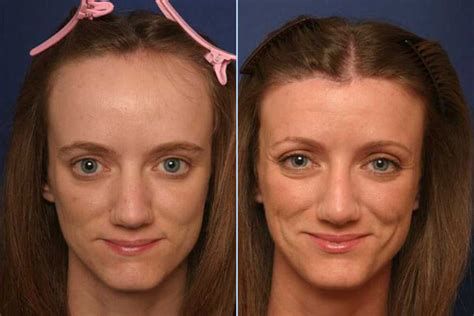Forehead reduction surgery (also known as hairline lowering surgery) is a procedure that moves the hairline down and makes the forehead smaller. If you have a high forehead, this can be a very effective option for you.
Who is an ideal candidate for forehead reduction surgery?

Men and women who have a high forehead or receding hairline may be good candidates for forehead reduction surgery. This procedure will lower the hairline and make your forehead appear smaller, resulting in a more balanced facial appearance.
How is forehead reduction surgery done?

Before the procedure begins, Dr. Zakhary will use a special pen to draw on your scalp where the incisions will be made. After you’re properly anesthetized, he will cut along these lines and remove the excess skin from your scalp before sewing you up again. The stitches are generally removed between 7-14 days after surgery.
Forehead reduction surgery is a surgical procedure that reduces the size of the forehead by bringing the hairline forward. Forehead reduction surgery can be performed for cosmetic purposes or in order to improve vision.
Forehead Reduction Surgery vs. Hair Transplant Surgery
Hair transplant surgery and forehead reduction surgery are different procedures. In hair transplant surgery, hair follicles from a different location on the patient’s body are transplanted onto the scalp, often in areas where there is balding. During forehead reduction surgery, however, no hair follicles are transplanted; instead, the surgeon reduces the size of the patient’s forehead by bringing the hairline forward and reducing its overall size.
Forehead reduction surgery is a procedure to reduce the size of the forehead. It may also be called browplasty.
The reason for having forehead reduction is usually to shorten a long forehead, lower or reshape high or protruding eyebrows or correct an asymmetrical forehead.
Incisions are made in the scalp and excess bone and tissue removed. The skin is then stitched together. Small incisions are sometimes made in the scalp where hair grows, so that the scars will be hidden by it.
Your surgeon will talk you through any risks, possible complications and recovery periods before your surgery. You should be aware that some risk factors, such as high blood pressure, can increase your risk of complications after surgery, regardless of where you have it done.
A high forehead, or one with a prominent glabella (the area between the eyebrows), can make it difficult to apply makeup and will be very noticeable.
Forehead reduction surgery is a procedure that reduces the height of the forehead by lowering the hairline and moving the hairline forward. Forehead reduction surgically moves the hairline lower and forward by removing part of the bone of the skull and replacing it with your own hair-bearing skin from behind your ear. This is done in such a way as to keep all of your natural hair as well as any existing hair transplants you may have had.
Most people who undergo this procedure want to enhance their eye area, bringing balance to their face and giving them a more youthful appearance. A prominent forehead can accentuate aging, making you look older than you are. For men, having a high forehead may not be a big deal but for women it can make putting on makeup more challenging. Some women even go so far as to wear bangs all of their lives because they don’t like their large foreheads.
You are probably an excellent candidate for forehead reduction surgery if:
You have an overly large forehead that makes you feel self-conscious about your appearance
You feel that your high forehead makes you look older
This is a cosmetic surgery procedure to reduce the size of the forehead. Forehead reduction involves taking out bone and soft tissue from the forehead, then placing grafts where this tissue was removed. The patient’s own bone and tissue are used as the grafts. Forehead reduction is a complex surgery that requires a skilled surgeon who has advanced training and experience with this procedure.
Forehead reduction basically moves all of the tissues in the forehead area (skin, muscle, fat, nerve, blood vessel) down to shorten the distance between the eyebrows and scalp. This surgery also moves these tissues forward toward the facial plane so that the eyebrows do not appear sunken in or have a hollowed-out appearance.
It can take many months for swelling to fully resolve after forehead reduction surgery. The forehead may feel tight and numb during this time. It may also feel tender when touched or when exposed to cold air or wind.
Forehead reduction surgery is a procedure that aims to reduce the forehead’s length by shortening its vertical height. It involves the removal of a small amount of the forehead’s vertical length in order to make it appear shorter. This can be done through traditional scalp incisions, or it can also be done endoscopically with no scalp incision at all. Forehead reduction surgery can also be performed in conjunction with other cosmetic facial surgeries such as brow lifts, wrinkle removal, and eyelid surgery.
Forehead reduction surgery is a procedure to reduce a high forehead. A high forehead is one that extends from the hairline to the eyebrows, preventing a more natural-looking brow line.
The surgery can be performed in two ways: either by extracting bone or by removing bone and replenishing it with man-made materials.
Surgical procedures to reduce the size of the forehead are performed under general anesthesia and may take from 2 to 6 hours, depending on the techniques used. The hospital stay is approximately 24 hours for observation.
